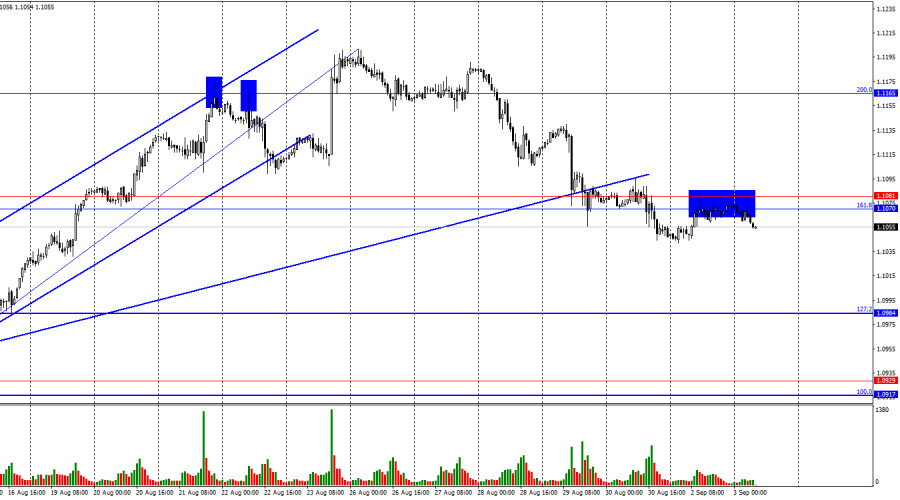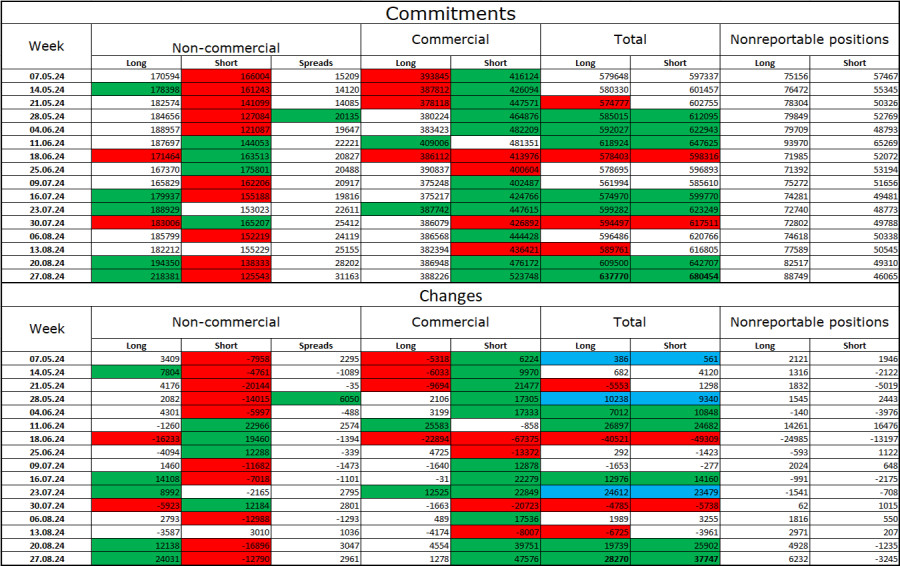
On Monday, the EUR/USD pair returned to the resistance zone of 1.1070–1.1081, rebounded from it, and shifted in favor of the U.S. dollar. This renewed the downward movement towards the nearest corrective level of 127.2% at 1.0984. I fully support the further decline of the euro, but this week, U.S. reports might once again work against the dollar. Therefore, it's crucial to closely monitor all incoming data from the U.S.

The wave situation has become slightly more complicated, but overall it raises no significant questions. The last completed upward wave broke the peak of the previous wave, while the new downward wave has not yet come close to the last low from August 15. Thus, the "bullish" trend currently remains intact. For the "bullish" trend to be invalidated, the bears must break the low of the most recent downward wave, located near the 1.0950 level. To start with, they need to close at least below the trendline.
There was no significant information background on Monday, but today the first data of the week from the U.S. will start coming in. The week starts with the manufacturing sector activity indices. While the S&P index is considered secondary, the ISM index is of primary importance. Therefore, by the second half of the day, traders will start receiving answers to the question of whether to expect support from the U.S. in the coming days. In my opinion, it's unlikely that the ISM index will show a significantly high value. Trader expectations are set at 47.5 points, and this value is unlikely to be significantly exceeded. However, the U.S. economy continues to grow at a high pace, and business activity indices are leading indicators. Technical analysis suggests a likely continuation of the U.S. dollar's rally, but business activity indices are less influential compared to labor market and unemployment data. The crucial decisions will be made on Friday.
On the 4-hour chart, the pair has consolidated below the 100.0% Fibonacci level at 1.1139, which suggests the possibility of the euro falling towards the 76.4% corrective level at 1.1013. A rebound from the 1.1013 level would suggest a reversal in favor of the euro and some growth towards 1.1139. No emerging divergences are observed on any indicator today.
Commitments of Traders (COT) Report

During the last reporting week, speculators opened 24,031 long positions and closed 12,790 short positions. The sentiment of the "Non-commercial" group shifted to "bearish" a few months ago, but currently, bulls are actively dominating. The total number of long positions held by speculators is now 218,000, while short positions amount to 125,000.
I continue to believe that the situation will shift further in favor of the bears. I don't see any long-term reasons to buy the euro. I would also like to note that the market has already fully priced in the expected September FOMC rate cut. The potential for the euro's decline appears significant. However, we should not forget about technical analysis, which at this point does not confidently indicate a strong euro decline, as well as the information background.
News Calendar for the U.S. and the Eurozone:
U.S. – Manufacturing PMI (13:45 UTC)U.S. – ISM Manufacturing PMI (14:00 UTC)On September 3, the economic events calendar contains only two entries. The impact of the information background on trader sentiment in the second half of the day could be significant.
Forecast for EUR/USD and Trading Tips:
Selling the pair could have been considered upon a rebound from the 1.1070–1.1081 zone with a target of 1.0984. These trades can now be kept open. Buying will be possible if the pair closes above the 1.1070–1.1081 zone on the hourly chart, with a target of 1.1165.
Fibonacci levels are constructed from 1.0917–1.0668 on the hourly chart and from 1.1139–1.0603 on the 4-hour chart.